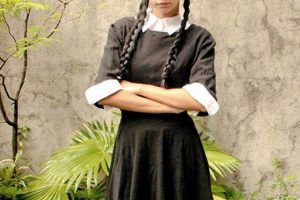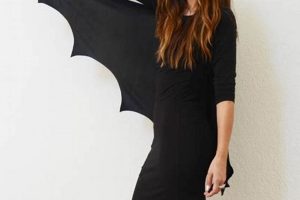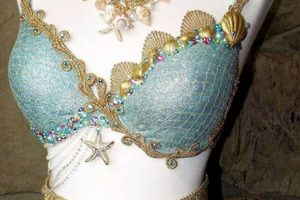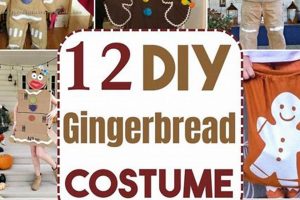A homemade amphibian-themed outfit represents an avenue for creative expression and cost-effective costume creation. This involves designing and constructing attire that replicates or evokes the appearance of a frog, typically utilizing readily available materials and basic crafting techniques. Examples range from simple green-colored clothing with added eyes to more elaborate designs incorporating features like webbed feet or inflatable bodies.
The appeal of crafting a frog-inspired ensemble lies in its accessibility and potential for personalization. This approach offers a budget-friendly alternative to purchasing pre-made costumes and fosters imaginative problem-solving during the design and construction phases. Historically, homemade costumes have played a significant role in celebrations and performances, providing a means for individuals to embody characters or themes without substantial financial investment.
The subsequent sections will delve into specific methods and considerations for realizing various amphibian-inspired costume designs, examining material selection, construction techniques, and options for customization. These will explore various approaches suitable for different skill levels and desired levels of detail.
Construction Tips for Amphibian-Themed Attire
The following guidelines offer practical advice for individuals undertaking the construction of homemade amphibian-themed attire. Attention to detail and careful material selection are crucial for achieving a satisfactory outcome.
Tip 1: Color Selection. Opt for fabrics and materials in shades of green, brown, or yellow to accurately represent common amphibian coloration. Consider incorporating mottled patterns or textures to mimic skin variations.
Tip 2: Pattern Creation. Prioritize creating a pattern before cutting fabric. This ensures accurate sizing and minimizes material waste. Utilize existing clothing items as templates or consult online resources for adaptable patterns.
Tip 3: Material Choice. Prioritize lightweight and breathable materials such as felt, fleece, or cotton. Avoid excessively stiff or heavy fabrics that may restrict movement and cause discomfort.
Tip 4: Eye Construction. Construct prominent eyes using craft foam, ping pong balls, or repurposed plastic containers. Securely attach the eyes to the costume headpiece or hood, ensuring they are positioned for optimal visibility and aesthetic effect.
Tip 5: Webbed Feet. Implement webbed feet using fabric scraps or craft foam. Securely attach the webbing to footwear using adhesive or stitching, ensuring they are durable and do not impede mobility.
Tip 6: Inflation Techniques. Consider incorporating inflatable elements for a more exaggerated amphibian appearance. Utilize balloons, inflatable toys, or repurposed plastic bags to create volume and shape. Ensure inflation mechanisms are secure and pose no safety hazards.
Tip 7: Safety Considerations. Prioritize safety throughout the construction process. Use non-toxic adhesives and paints. Ensure all costume components are securely attached and pose no risk of entanglement or obstruction.
Adhering to these guidelines will contribute to the creation of a visually appealing, durable, and safe homemade amphibian-themed attire.
The subsequent section provides information on additional design elements to enhance the overall costume appearance.
1. Green coloration
Green coloration is fundamental to the visual representation of a frog in homemade attire. The selection of green hues directly impacts the recognizability and authenticity of the “frog diy costume.” A cause-and-effect relationship exists: the choice of appropriate green tones enhances the costume’s resemblance to a frog, whereas an inaccurate color selection diminishes the desired effect. For instance, a vibrant, artificial green might suggest a cartoonish interpretation, while a more muted, earthy green aligns with realistic amphibian depictions. Improper color choices can negatively affect the theme of the whole frog diy costume.
The significance of green extends beyond mere aesthetics. It is a primary identifying characteristic associated with frogs in popular culture and scientific understanding. Examples include the iconic Kermit the Frog, whose green appearance immediately establishes his identity, and various species of tree frogs, whose camouflage relies heavily on their verdant coloration. Applying this understanding to “frog diy costume” construction enables individuals to create more convincing and effective representations. By carefully selecting green fabrics and materials that mimic natural amphibian skin tones, creators can enhance the overall impact of their homemade attire.
In conclusion, green coloration serves as a linchpin element in the crafting of effective “frog diy costume”. The strategic utilization of appropriate green shades directly influences the costume’s authenticity and recognizability, aligning with both cultural perceptions and scientific observations. The accuracy of the green tones used significantly determines the success of the costume’s portrayal of a frog. Understanding the importance of this element allows for informed decision-making during the material selection and design phases, ultimately resulting in a more compelling and visually accurate representation.
2. Pattern simplicity
Pattern simplicity, within the context of crafting an amphibian-themed homemade outfit, directly influences the feasibility and ultimate success of the undertaking. The complexity of the pattern selected significantly affects the required skill level, time investment, and resource allocation for the costume’s creation.
- Reduced Construction Time
Simplified patterns necessitate fewer steps and intricate techniques, thereby reducing the overall construction time. A basic frog costume, for instance, can be achieved using a simple poncho-style pattern with minimal sewing, allowing for quicker completion. Complex patterns involving numerous pieces and detailed stitching increase production time substantially.
- Lower Skill Requirement
Less intricate patterns are more accessible to individuals with limited sewing or crafting experience. A novice can successfully create a rudimentary frog costume using basic shapes and straightforward assembly methods. Conversely, elaborate patterns demand advanced skills in pattern reading, cutting, and stitching, potentially exceeding the capabilities of beginner crafters.
- Minimized Material Waste
Simple patterns typically utilize fewer individual fabric pieces, minimizing material waste during the cutting and assembly stages. A straightforward design requires less fabric manipulation, resulting in lower levels of discarded scraps. Conversely, complex patterns with numerous curved or angled
pieces often lead to greater fabric wastage, increasing overall material costs. - Enhanced Customization Potential
A basic pattern provides a foundation for customization, allowing for the addition of personalized details and embellishments. Individuals can easily modify a simple frog costume pattern by adding features such as oversized eyes, webbed feet, or inflatable elements. Complex patterns, with their pre-defined shapes and structures, often limit the scope for individual expression and customization.
These facets of pattern simplicity underscore its critical role in the creation of homemade amphibian-themed attire. By prioritizing straightforward designs, creators can enhance the accessibility, efficiency, and personalization of their projects, ensuring a successful and satisfying costume-making experience. The ease of construction stemming from a simple pattern directly correlates with the overall enjoyment and likelihood of successful completion of the “frog diy costume.”
3. Material comfort
Material comfort constitutes a significant factor in the practicality and wearability of a “frog diy costume.” The tactile properties of chosen materials directly affect the wearer’s experience, influencing factors such as breathability, range of motion, and overall comfort level. Discomfort arising from scratchy, restrictive, or excessively warm materials can detract from the costume’s intended enjoyment and limit its suitability for extended wear or active participation in events.
The selection of appropriate materials presents a cause-and-effect relationship directly linked to the costume’s functionality. For instance, the choice of breathable cotton or moisture-wicking fleece can mitigate overheating during prolonged wear, while stiff or non-stretch fabrics can impede movement and cause discomfort. Examples of suitable materials include felt for basic shapes, fleece for its softness and warmth, and lightweight cotton for breathability in warmer climates. Conversely, materials such as vinyl or non-breathable synthetics should be avoided due to their potential to trap heat and restrict airflow. The strategic selection of comfortable materials is not merely a matter of preference but a crucial element in ensuring the costume is both visually appealing and functionally suitable for its intended purpose. Consider the use of hypoallergenic materials for wearers with sensitive skin to prevent irritation. The lack of consideration for the wearer is impractical.
In summary, material comfort holds paramount importance in the successful creation of a functional and enjoyable “frog diy costume.” The mindful selection of materials, prioritizing breathability, flexibility, and tactile comfort, directly enhances the wearer’s experience and extends the costume’s usability. Addressing potential challenges, such as cost limitations or material availability, necessitates a balance between aesthetic goals and practical considerations. Ultimately, the goal is to create a costume that not only resembles a frog but also provides a comfortable and enjoyable wearing experience.
4. Eye prominence
Eye prominence is a defining characteristic of many frog species, consequently becoming a crucial visual element in an amphibian-themed homemade outfit. The size, shape, and placement of the eyes significantly contribute to the recognizability and overall aesthetic impact of the “frog diy costume.” A properly executed design will prioritize these features, creating a more convincing and visually appealing representation of a frog. Neglecting this element can result in a costume that lacks the distinctive features associated with the animal, diminishing its intended effect.
The relationship between eye prominence and visual impact manifests in various ways. Oversized, bulging eyes, constructed from materials like craft foam or ping pong balls, immediately convey the characteristic amphibian appearance. Strategic placement on the head, often positioned slightly above the plane of the face, further enhances this effect. For instance, consider the common depiction of cartoon frogs, where exaggerated eyes are a primary identifier. Similarly, realistic frog costumes often employ techniques to create the illusion of wide, forward-facing eyes. The application of these principles elevates the overall quality and believability of the costume.
In conclusion, eye prominence serves as a key design consideration in crafting effective “frog diy costume.” The accurate representation of this feature, through careful material selection and strategic placement, significantly enhances the costume’s visual appeal and recognizability. The effort invested in achieving appropriate eye prominence directly translates to a more convincing and aesthetically pleasing outcome. Therefore, creators should prioritize this aspect throughout the design and construction phases to maximize the impact of their homemade creation.
5. Webbing functionality
Webbing functionality directly impacts the authenticity and practical usability of a homemade amphibian-themed outfit. The presence and design of webbed appendages, typically representing the interdigital membranes between a frog’s toes, contribute significantly to the visual accuracy of the “frog diy costume.” Furthermore, functional webbing, even if stylized, can enhance the wearer’s ability to mimic amphibian movements and participate in activities while costumed. The absence of webbing, or poorly designed webbing that impedes movement, detracts from both the aesthetic and practical aspects of the costume.
The integration of webbing into footwear demonstrates a cause-and-effect relationship: appropriate material selection and secure attachment methods result in durable and functional webbed feet, whereas inadequate construction leads to tearing, detachment, or restricted mobility. Examples range from simple fabric gussets sewn between the toes of gloves or shoes to more elaborate designs utilizing flexible materials like neoprene or rubber. A child’s frog costume designed for a school play benefits from functional webbing that allows for simulated hopping and swimming motions, enhancing the performance. A poorly constructed “frog diy costume” could create a tripping risk for the wearer.
In conclusion, webbing functionality is a vital component of an effective “frog diy costume,” influencing both its visual appeal and practical usability. Careful consideration of materials, construction techniques, and wearability ensures that the webbed appendages enhance the overall costume experience. Balancing aesthetic accuracy with practical considerations remains a key challenge, requiring creators to prioritize both visual representation and the wearer’s comfort and mobility. An informative piece is to serve as a guide or tutorial for potential builders and enthusiasts.
6. Safety adherence
Safety adherence represents a critical consideration in the construction of any homemade attire, including a “frog di
y costume.” Neglecting safety protocols can lead to physical harm, rendering the costume unsuitable for wear and negating its intended purpose.
- Non-Toxic Material Selection
The selection of non-toxic materials is paramount to prevent skin irritation, allergic reactions, or potential ingestion of harmful substances. Fabric dyes, adhesives, and embellishments must be certified as non-toxic and safe for prolonged skin contact. Children are particularly vulnerable, increasing the necessity for material scrutiny in costumes intended for juvenile wearers. Uncertified materials could potentially lead to skin irritation and hospitalization in the most extreme situation.
- Secure Component Attachment
Costume components, such as eyes, limbs, or decorative elements, must be securely attached to prevent detachment during wear. Loose components pose a choking hazard for young children and can present tripping hazards for wearers of all ages. Stitching, durable adhesives, and reinforced attachment points are essential for ensuring component security. Unsecured elements risk choking the wearer.
- Visibility Considerations
Costume designs should not impede the wearer’s vision or restrict their range of motion. Eye openings must be adequately sized and positioned to allow for clear peripheral vision. Bulky or cumbersome designs can increase the risk of falls or collisions, particularly in crowded environments. Restricted visibility can easily lead to accidents for the costume wearer.
- Flammability Standards
Fabric selection must adhere to flammability standards to minimize the risk of fire-related injuries. Lightweight, synthetic fabrics are often highly flammable and should be avoided or treated with flame retardant coatings. Natural fibers, such as cotton or wool, offer inherently greater fire resistance. Ignoring this standard increases the chance of injury from fire exposure.
These safety considerations are integral to the responsible creation of a “frog diy costume.” Prioritizing non-toxic materials, secure component attachment, adequate visibility, and adherence to flammability standards ensures a safe and enjoyable experience for the wearer. The balance of creative design and safety consciousness produces a costume that is not only visually appealing but also fit for purpose.
7. Cost effectiveness
Cost effectiveness plays a pivotal role in the decision-making process for creating an amphibian-themed outfit at home. The availability of budget-friendly materials and the potential for resourcefulness directly influence the accessibility and appeal of the “frog diy costume” endeavor. A cause-and-effect relationship emerges: limited financial resources necessitate creative solutions and repurposed materials, whereas readily available, inexpensive supplies streamline the construction process. The significance of cost effectiveness lies in its ability to democratize costume creation, enabling individuals with varying financial means to participate in creative expression. For instance, utilizing discarded clothing items, repurposed cardboard, or discounted craft supplies reduces the overall expense, making the project attainable for a wider audience.
Practical application of cost-effective strategies involves sourcing materials from thrift stores, utilizing online coupons for fabric and craft supplies, and employing readily available household items in the costume construction. Examples include using green-colored plastic grocery bags to create a makeshift webbed foot design, repurposing an old umbrella frame for a frog-like head structure, or utilizing egg cartons to fashion bulging eyes. The application of cost-saving measures enables individuals to minimize expenses without sacrificing creative potential or visual appeal.
In summary, cost effectiveness remains a central consideration in the creation of homemade amphibian-themed outfits. The ability to construct a visually appealing and functional “frog diy costume” within a reasonable budget enhances the accessibility and appeal of the project. The primary challenge lies in balancing cost-saving measures with the desired level of quality and detail. Prioritizing resourcefulness, creative problem-solving, and strategic material sourcing ultimately ensures a successful and affordable costume-making experience.
Frequently Asked Questions About Constructing Homemade Amphibian-Themed Attire
The following questions and answers address common concerns and misconceptions associated with the creation of homemade amphibian-themed attire, providing guidance for individuals undertaking such projects.
Question 1: What are the most suitable materials for crafting a “frog diy costume” intended for extended outdoor wear?
Durable, weather-resistant materials such as ripstop nylon or treated canvas are recommended for outdoor applications. These materials offer protection from the elements and withstand greater wear and tear than lighter fabrics. Ensure seams are reinforced and waterproofed for added durability.
Question 2: How can a “frog diy costume” be made safe for young children?
Safety precautions include using non-toxic materials, securely attaching all costume components to prevent choking hazards, and ensuring unrestricted visibility. Avoid small parts that could be ingested, and select flame-retardant fabrics to minimize fire risks.
Question 3: What are the most common pitfalls to avoid when constructing a “frog diy costume” for individuals with mobility limitations?
Restrictive designs that impede movement should be avoided. Prioritize lightweight, flexible materials and ensure the costume allows for a full range of motion. Avoid bulky or cumbersome elements that could hinder mobility or create tripping hazards.
Question 4: How can the authenticity of a “frog diy costume” be enhanced while maintaining budget constraints?
Resourcefulness is key. Repurpose existing materials such as old clothing or fabric scraps to reduce expenses. Focus on accurately representing key characteristics such as color, eye shape, and webbing, even if employing simplified designs.
Question 5: What are the best methods for cleaning and maintaining a “frog diy costume” made from delicate materials?
Handwashing with mild detergent is recommended for delicate fabrics. Avoid harsh chemicals or machine washing, which can damage the materials. Allow the costume to air dry completely to prevent mold or mildew growth. Check your frog diy costume from time to time and see if there’s any damages to the costume.
Question 6: How can a “frog diy costume” be adapted for different seasonal conditions, ensuring comfort and practicality year-round?
Layering techniques can be employed to adapt the costume for varying temperatures. Use breathable fabrics for warmer weather and add insulating layers for colder conditions. Ensure the costume remains comfortable and functional regardless of the season.
In summary, the successful creation of homemade amphibian-themed attire hinges on careful material selection, adherence to safety protocols, and resourceful design choices. Prioritizing practicality and wearability ensures a satisfying and functional outcome.
The next section provides detailed instructions for constructing specific components of the costume, such as the headpiece and webbed feet.
Concluding Remarks on Amphibian-Themed Homemade Attire
Th
e preceding exposition has explored the multifaceted aspects of the ‘frog diy costume’, encompassing design considerations, construction techniques, safety protocols, and cost-effective strategies. Essential elements such as green coloration, pattern simplicity, material comfort, eye prominence, webbing functionality, safety adherence, and cost-effectiveness have been examined in detail, providing a comprehensive understanding of the subject matter.
The creation of a homemade amphibian-themed outfit represents a confluence of creativity, resourcefulness, and practical skill. The information presented herein serves as a foundation for individuals seeking to embody the essence of a frog through handcrafted attire. Further exploration and experimentation are encouraged, fostering innovation in design and construction techniques within the realm of homemade costume creation.







